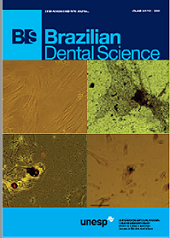Evaluation of marginal fit and microleakage of monolithic zirconia crowns cemented by bio-active and glass ionomer cements: In vitro study
DOI:
https://doi.org/10.14295/bds.2020.v23i1.1824Abstract
Objective: To evaluate the marginal fit and microleakage of monolithic zirconia crowns cemented with bioactive cement (Ceramir) compared to that cemented with glass ionomer cement and to evaluate the effect of thermocycling on marginal fit. Materials and methods: Twenty sound human molar teeth were prepared to receive a monolithic zirconia crowns. Teeth were divided randomly into two equal groups according to the type of luting cement. Group I: glass ionomer cement and group II: Ceramir cement. After cementation, the vertical marginal gap was assessed by using stereomicroscope before and after thermocycling. Twenty equidistant measurement points were taken for each crown. Leakage assessment was carried out using Fuchsin dye penetration followed by digital photography under a stereomicroscope. Data were analyzed by Mann-Whitney U test to compare between the two luting cements. Wilcoxon signed-rank test was used to evaluate the effect of thermocycling on the marginal fit (P ? 0.05)?Results: Whether before or after thermocycling, the results showed no significant difference between the marginal gap values of the two tested groups. For both groups, there was a significant increase in marginal gap values after thermocycling. Also, there was no significant difference between leakage scores of the two tested groups. Conclusions: Similarity in the physical properties and chemical composition of the two cements result in a non- significant effect on the vertical marginal fit and the extent of microleakage of translucent zirconia crowns. Thermocycling had a negative impact on the vertical marginal gap of the two tested luting agents.
Downloads
Downloads
Additional Files
Published
How to Cite
Issue
Section
License
Brazilian Dental Science uses the Creative Commons (CC-BY 4.0) license, thus preserving the integrity of articles in an open access environment. The journal allows the author to retain publishing rights without restrictions.
=================




























